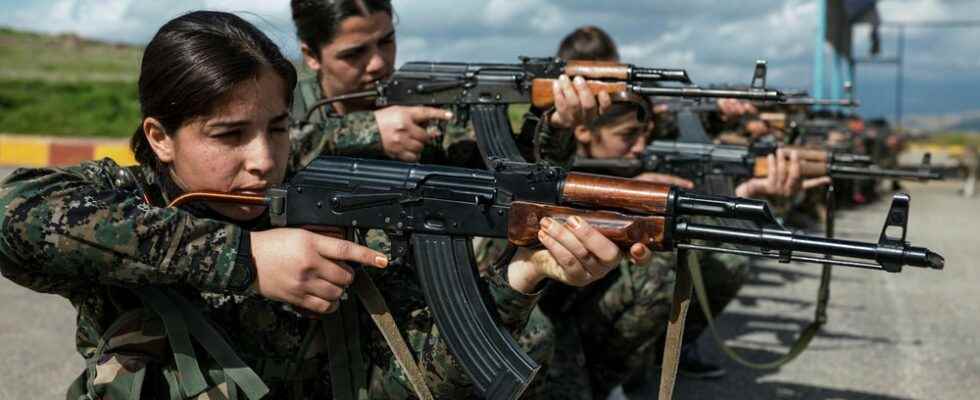The Kurds in Turkey and in Syria are the same Kurds. They speak the same dialect. Their clans have their hometowns on both sides of the border, which were completely open during the Ottoman period and which even today cannot be hermetically guarded. When Syria’s dictator Hafez al-Assad in the 1970s allowed the PKK to act against Turkey from Syria, the organization became entrenched on both sides of the border. When Turkey forced al-Assad to ban the PKK in 1998, contacts between the PKK and the Syrians trained by the organization did not end. During the Syrian civil war, it became important for various reasons for the Syrian Kurds to mark the distance to the PKK, and in 2011 its armed forces chose the name YPG.
What is happening now cannot be understood without a look back. In June 2014, the world was shaken when Mosul, one of Iraq’s major cities, was stormed by IS – hitherto best known for rapes and televised murders. A few weeks later, IS stood at the gates of Baghdad. The movement also controlled Raqqa, one of Syria’s major cities, and expanded in all directions. In the north, it was almost at the Syrian-Turkish border – NATO’s southern border. The only obstacle in its path was the small Kurdish town of Kobani.
The natural thing would have been if the most affected NATO member, Turkey, had moved out against IS. Ankara had other plans. The newspaper Cumhuriyet would later claim that Turkey’s security service MIT, while IS was spreading in northeastern Syria, was carrying equipment to jihadists in the area.
What would the United States do? President Barack Obama had promised to call home troops from the region. But IS must be stopped, unless large parts of the Middle East were to be thrown back to the Stone Age. Cooperation with al-Qaeda or with the bloodthirsty Syrian regime was unthinkable. The situation was saved with a bold move: an improvised US-YPG alliance, where the circumnavigated Kurds in Kobani learned to send GPS positions to the US air base al-Udeid in Qatar. The bombings began in September.
IS called its fighters from across the region to Kobani, but they were grounded by US and British airstrikes, which lasted around the clock for four months. The whole world followed breathlessly, and Turkey incurred global disgust for its refusal to release supplies to the besieged. After six weeks of fighting, Turkey yielded to US demands and opened the way to Kobani.
Victory in Kobani became a major media drama. The YPG, with its female warriors, became heroes. A few days after the decision in January 2015, an even worse cold shower came for the Turkish leadership: Defense Minister Chuck Hagel announced that the United States would now begin training Kurdish forces for the continued fight against IS. For Turkish Kurdophobes, this was an anxiety scenario: the PKK, or its shadow YPG, in alliance with the United States, and with autonomous territories along almost the entire long border with Turkey.
The situation in Turkey was light years from today: the same regime that today laments Sweden’s indirect relations with the PKK and the YPG had in January 2015 negotiated with the PKK for seven years. This was the work of President Recep Tayyip Erdogan. Despite outcry from right-wing nationalists, and despite constant sabotage from his (then) allies in the Gülen movement, Erdogan managed to bring the military leadership to peace talks with the PKK, first in the Norwegian capital Oslo, then on the Turkish island of Imrali in the Marmara Sea, where PKK leader Abdullah Öcalan is imprisoned. In 2013, the PKK began moving its weapons out of Turkey.
The Kurdish question, which has plagued Turkey for decades, was about to be resolved as the Syrian war spoiled plans. Giving autonomy to Turkey’s Kurds was one thing, doing so with a Kurdish de facto state on the other side of the border was something the Turkish military did not tolerate. They forced Erdogan to scrap the peace process, and in the summer of 2015, violence broke out again.
Sweden is doing everything in its power to ensure that none of its generous support for the YPG-controlled zone can be traced directly to the YPG. These enormous efforts indicate that the Ministry of Foreign Affairs realizes that it is unprofitable to try to separate the PKK and the YPG. If the new realities force Sweden (and other NATO members) to distance themselves from Rojava, it will be a great disappointment for the minorities there. But not catastrophic, as long as the United States holds its hand over them. However, US support is a volatile resource. In 2019, when Turkey took over large parts of Rojava, President Donald Trump let it happen – and was branded a traitor by an almost united Sweden.
Facts. The abbreviations
AANES. The “Autonomous Administration of Northern and Eastern Syria”, commonly known as Rojava, has been a separate political entity for more than ten years, with a Kurdish majority and Assyrian, Armenian and Arab minorities. AANES has gradually shrunk during a series of Turkish invasions in Syria 2016–2019.
PKK. The Kurdistan Workers’ Party, founded in 1978, is a communist party and a guerrilla movement, classified as terrorist by the EU and the United States. In 1984, the PKK launched an armed uprising against Turkey, which degenerated into a long and bloody war, in which Turkey forcibly displaced large sections of the Kurdish population.
PYD is a political party, founded in 2003 as a Syrian offshoot of the PKK, which was then no longer allowed to operate in Syria.
YPG“The People’s Defense Units”, is a mainly Kurdish militia, formally the armed arm of the PYD party.
YPJ“Women’s Defense Units”, is the YPG militia’s female unit.
SDF“Syrian Democratic Forces”, is a YPG-dominated alliance of militias in the autonomous parts of northeastern Syria.
Show more
